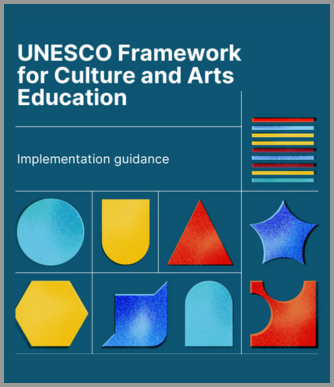Implementation Guidance for UNESCO Framework for Culture and Arts Education

Íoslódáil: "Implementation Guidance for UNESCO Framework for Culture and Arts Education"
UNESCO has published (29 September 2025) practical guidelines to help integrate culture and the arts into formal, non-formal and informal education throughout life.
This new Implementation Guidance translates the Framework for Culture and Arts Education — adopted at the UNESCO World Conference on Culture and Arts Education in Abu Dhabi, UAE, in 2024 — into concrete, actionable policy and practice. This new resource is designed to help Member States, Associate Members, and educational and cultural stakeholders integrating culture and the arts across formal, non-formal, and informal learning settings, with an emphasis on inclusion, cultural diversity, co-creation, and lifelong learning.
Who is this guidance for?
The Implementation Guidance for the UNESCO Framework for Culture and Arts Education aims to provide practical recommendations for a broad range of stakeholders:
- Policymakers: Ministries of Education and Culture and other intersectoral national bodies translating the Framework into national policies and strategies.
- Educators and cultural professionals who design curricula, programmes, and learning environments that promote inclusion and respect for cultural diversity.
- Youth and civil society actors co-creating content and practices to ensure relevance, innovation, and community engagement.
What’s in the Guidance?
The Implementation Guidance for the UNESCO Framework for Culture and Arts Education joins high-level vision to tangible action. Each of its sections outlines concrete expected outcomes, depicting the envisioned reality resulting from the implementation of the recommendations, as well as guiding questions to help stakeholders assess the progress achieved.
The Guidance provides recommendations for policymakers on developing long-term strategies, strengthening coordination, and embedding culture and the arts into education systems. It also features practical tips for practitioners, for integrating culture and the arts into classrooms, technical training, higher education, and community learning.
Perhaps most remarkably, the Guidance highlights illustrative examples from 52 countries across all regions of the world, showcasing a diversity of innovative initiatives in culture and arts education. These range from institutional approaches, such as Chile’s Artistic Education Policy or Türkiye’s specialised teacher training programmes, to digital learning innovations like Lithuania’s online Competence Library developing cultural knowledge and skills. Examples also include practices reaching communities through art and music festivals in Azerbaijan, Iran and Morocco, using tangible heritage such as the Apartheid Museum in South Africa, or a Pakistani Radio Programme providing cultural learning to marginalised groups.
Read more about Implementation Guidance for UNESCO Framework for Culture and Arts Education.
Íoslódáil"Implementation Guidance for UNESCO Framework for Culture and Arts Education"